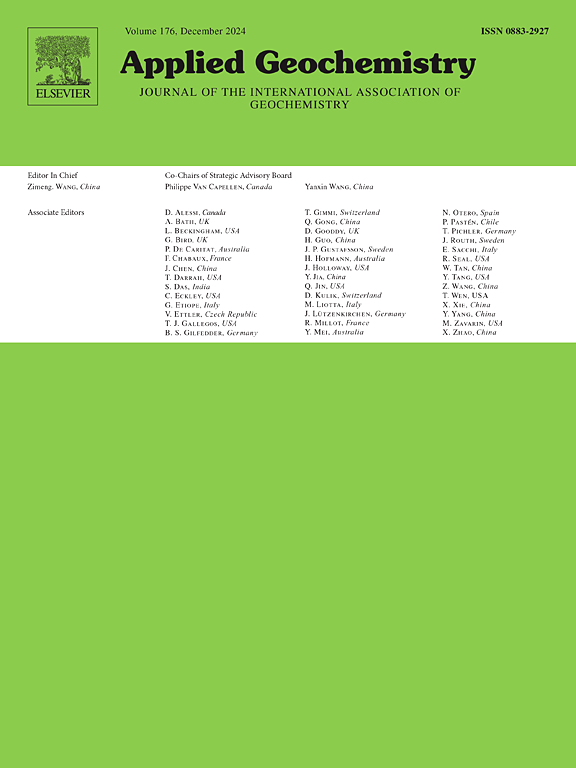Mixed nitrogen inputs affected nitrate distribution and biogeochemical processes during ice-covered and ice-free periods in a boreal eutrophic steppe lake basin
IF 3.4
3区 地球科学
Q1 GEOCHEMISTRY & GEOPHYSICS
引用次数: 0
Abstract
Nitrogen enrichment from nitrate is a significant contributor to water quality eutrophication in various freshwater basins. However, the input pathways and transformation processes of nitrate remain unclear, particularly during different hydrological processes in boreal eutrophic steppe lake basins that are susceptible to human activity and climate change stressors. In this study, we experimentally investigate the nitrogen sources, transport and transformation in the high-latitude Hulun Lake basin during both ice-covered and ice-free periods using the dual stable isotopes of nitrate (δ15N–NO3- and δ18O–NO3-) with the Stable Isotope Analysis in R (SIAR) model. Our results indicate that nitrate input contributed to water body eutrophication in the Hulun Lake basin, with varying inputs during different hydrological processes. Our quantitative analysis reveals that during the ice-covered period, manure/sewage water (MS) was the dominant nitrate input pathway, accounting for 55.3%, while atmospheric precipitation (AP) contributed the most at 49.8% during the ice-free period. The primary transport and transformation process of nitrate was further identified as nitrification instead of denitrification, as evidenced by the Cl− and NO3−/Cl− levels and redundancy analysis. This study highlights the complexity of nitrate input pathways and transformation processes under different hydrological conditions and emphasizes their significant impact on the nitrogen cycle and ecology of water environments in boreal steppe lake basins.
混合氮输入影响了北方富营养化草原湖盆冰期和无冰期硝酸盐分布和生物地球化学过程
硝酸盐对氮的富集是各淡水流域水质富营养化的重要因素。然而,硝酸盐的输入途径和转化过程尚不清楚,特别是在易受人类活动和气候变化压力因素影响的北方富营养化草原湖盆的不同水文过程中。本研究利用R稳定同位素分析(SIAR)模式,利用硝酸盐的δ15N-NO3 -和δ18O-NO3 -双稳定同位素,对高纬度呼伦湖盆地在冰期和无冰期的氮源、运移和转化进行了实验研究。结果表明,在不同的水文过程中,硝酸盐的输入对水体富营养化有一定的促进作用。定量分析表明,在冰期,粪便/污水(MS)是主要的硝酸盐输入途径,占55.3%,而大气降水(AP)在无冰期贡献最大,占49.8%。通过Cl -和NO3 - /Cl -水平和冗余分析,进一步确定了硝酸盐的主要转运和转化过程是硝化而不是反硝化。本研究强调了不同水文条件下硝酸盐输入途径和转化过程的复杂性,强调了它们对北方草原湖盆水环境氮循环和生态的重要影响。
本文章由计算机程序翻译,如有差异,请以英文原文为准。
求助全文
约1分钟内获得全文
求助全文
来源期刊

Applied Geochemistry
地学-地球化学与地球物理
CiteScore
6.10
自引率
8.80%
发文量
272
审稿时长
65 days
期刊介绍:
Applied Geochemistry is an international journal devoted to publication of original research papers, rapid research communications and selected review papers in geochemistry and urban geochemistry which have some practical application to an aspect of human endeavour, such as the preservation of the environment, health, waste disposal and the search for resources. Papers on applications of inorganic, organic and isotope geochemistry and geochemical processes are therefore welcome provided they meet the main criterion. Spatial and temporal monitoring case studies are only of interest to our international readership if they present new ideas of broad application.
Topics covered include: (1) Environmental geochemistry (including natural and anthropogenic aspects, and protection and remediation strategies); (2) Hydrogeochemistry (surface and groundwater); (3) Medical (urban) geochemistry; (4) The search for energy resources (in particular unconventional oil and gas or emerging metal resources); (5) Energy exploitation (in particular geothermal energy and CCS); (6) Upgrading of energy and mineral resources where there is a direct geochemical application; and (7) Waste disposal, including nuclear waste disposal.
 求助内容:
求助内容: 应助结果提醒方式:
应助结果提醒方式:


